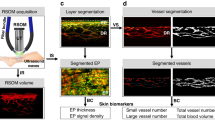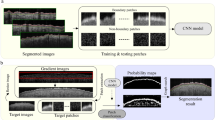Abstract
The optical scattering coefficient (μs) in the dermis layer of human skin obtained with optical coherence tomography (OCT) has shown to have a strong correlation with the blood glucose concentration (BGC), which can be used for noninvasive BGC monitoring. Unfortunately, the nonhomogeneity in the skin may cause inaccuracies for the BGC analysis. In this paper, we propose a 2D correlation analysis method to identify 2D regions in the skin with μs sensitive to BGC variations and only use data in these regions to calculate μs for minimizing the inaccuracy induced by nonhomogeneity and therefore improving the accuracy of OCT-based BGC monitoring. We demonstrate the effectiveness of the 2D method with OCT data obtained with in vivo human forearm skins of nine different human subjects. In particular, we present a 3D OCT data set in a two-dimensional (2D) map of depth vs. a lateral dimension and calculate the correlation coefficient R between the μs and the BGC in each region of the 2D map with the BGC data measured with a glucose meter using finger blood. We filter out the μs data from regions with low R values and only keep the μs data with R values sufficiently high (R-filter). The filtered μs data in all the regions are then averaged to produce an average μs data. We define a term called overall relevancy (OR) to quantify the degree of correlation between the filtered/averaged μs data and the finger-blood BGC data to determine the optimal R value for such an R-filter with the highest obtained OR. We found that the optimal R for such an R-filter has an absolute value (|R|) of 0.6 or 0.65. We further show that the R-filter obtained with the 2D correlation method yields better OR between μs and the BGC than that obtained with the previously reported 1D correlation method. We believe that the method demonstrated in this paper is important for understanding the influence of BGC on μs in human skins and therefore for improving the accuracy of OCT-based noninvasive BGC monitoring, although further studies are required to validate its effectiveness.







Similar content being viewed by others
References
C. C.T . Group, Nathan DM, Genuth S, Lachin J, Cleary P, Crofford O, Davis M, Rand L, Siebert C (1993) N.Engl.J.Med 329(3):977–986
Takashi M, Kokoro T, Fumi Y, Hiroshi O, Junichiro K, Kazunori Y, Naoki S (2015) J, Diabetes Invest 6(6):687–691
Andrews JT, Solanki J, Choudhary OP, Chouksey S, Malvia N, Chaturvedi P, Sen P (2012) J PhysConf 365:012004
Larin KV, Eledrisi MS, Motamedi M, Esenaliev RO (2002) Diabetes Care 25(12):2263–2267
Ullah H, Hussain F, Ikram M (2015) Appl Phys Bvol 120(2):1–12
Solanki J, Sen P, Andrews JT, Thareja KK (2012) J Opt 41(3):127–133
Esenaliev RO, Larin KV, Larina IV, Motamedi M (2001) Opt Lett 26(13):992–994
Su Y, Meng Z, Wang L, Yu H, Liu T, Yao XY (2014) Chin J Lasers 41:0704002
Kuranov RV, Sapozhnikova VV, Prough DS, Cicenaite I, Esenaliev RO (2006) Phys Med Biol 51(16):3885–3900
Hori Y, Yasuno Y, Sakai S, Matsumoto M, Sugawara T, Madjarova VD, Yamanari M, Makita S, Yasui T, Araki T, Itoh M, Yatagai T (2006) Opt Express 14(5):1862–1877
Bhandari A, Hamre B, Frette Ø, Stamnes K, Stamnes JJ (2011) Opt Express 19(15):14549
Su Y, Yao XS, Meng Z, Yu LWH, Liu T (2014) Chin Opt Lett 12(11):111701
MyDr (2015) Skin biology and structure. http://www.mydr.com.au/skin-hair/skin-biology-and-structure
Su Y, Yao XS, Wei CJ, Wang YM, Wang HJ, Li ZH (2015) Biomed Opt Express 6(2):500–513
Su Y, Yao XS, Wei CJ, Wang YM, Wang HJ, Li ZH (2016) IEEE Photonics J 8(1):1–10
Caduff A, Talary MS, Zakharov P (2010) Diabetes Technol Ther 12(1):1–9
Faber D, Van DMF, Aalders M, Van LT (2004) Opt Express 12(19):4353–4365
Laufer J, Simpson R, Kohl M, Essenpreis M, Cope M (1998) Phys Med Biol 43(9):2479–2489
Yao XS, Wang LZ, Meng Z China Patent 2015, 201310210400.0 [P]
Turani Z, Fatemizadeh E, Blumetti T, Daveluy S, Moraes AF, Chen W, Mehregan D, Andersen PE, Nasiriavanaki M (2019) Cancer Res 79(8):2021–2030
Lee CK, Tsai MT, Chang FY, Yang CH, Shen SC, Yuan O, Yang CH (2013) Sensors 13(4):4041–4050
Kholodnykh AI, Petrova IY, Larin KV, Motamedi M, Esenaliev RO (2003) Appl Opt 42(16):3027–3037
Yang Y, Wang T, Biswal NC, Wang X, Sanders M, Brewer M, Zhu Q (2011) J Biomed Opt 16:2143–2152
Coleman AJ, Richardson TJ, Orchard G, Uddin A, Choi MJ, Lacy KE (2013) Skin Res Technol 19(1):e10–e19
Schliesser JA, Gallimore G, Kunjukunju N, Sabates NR, Koulen P, Sabates FN (2014) Clin Ophthalmol (default):2337–2345
Tsukamoto Y, Kinoshita Y, Kitagawa H, Munekage M, Munekage E, Takezaki Y, Yatabe T, Yamashita K, Yamazaki R, Okabayashi T, Tarumi M, Kobayashi M, Mishina S, Hanazaki K (2013) Artif Organs 37(4):E67–E73
Larsson M, Nilsson H, Strömberg T (2003) Appl Opt 42(1):124
Larin KV, Motamedi M, Ashitkov TV, Esenaliev RO (2003) Phys Med Biol 48(10):1371
Graaff R, Aarnoudse JG, Zijp JR, Sloot PMA, de Mul FFM, Greve J, Koelink MH (1992) Appl Opt 31(10):1370–1376
Menon GK (2002) Adv Drug Deliv Rev 54(11):S3–S17
Gabbay RA, Sivarajah S (2008) Diabetes Technol Ther 10(3):188–193
Funding
This study was funded in part by the Natural Science Foundation of Hebei Province F2016201208, in part by the Youth Foundation of Hebei Educational Committee QN2017022, and in part by the Advanced Talents Program of Hebei Educational Committee GCC2014020.
Author information
Authors and Affiliations
Corresponding author
Ethics declarations
Conflict of interest
The authors declare that they have no conflict of interest.
Ethical approval
This study was independently reviewed and approved by the human subjects ethics board of the Affiliated Hospital of Hebei University and was conducted in accordance with the 1964 Helsinki declaration and its later amendments or comparable ethical standards. Informed consent was obtained from all individual participants included in the study.
Additional information
Publisher’s note
Springer Nature remains neutral with regard to jurisdictional claims in published maps and institutional affiliations.
Rights and permissions
About this article
Cite this article
Su, Y., Liu, H., Wang, H. et al. Two-dimensional correlation (2D) method for improving the accuracy of OCT-based noninvasive blood glucose concentration (BGC) monitoring. Lasers Med Sci 36, 1649–1659 (2021). https://doi.org/10.1007/s10103-021-03244-x
Received:
Accepted:
Published:
Issue Date:
DOI: https://doi.org/10.1007/s10103-021-03244-x




